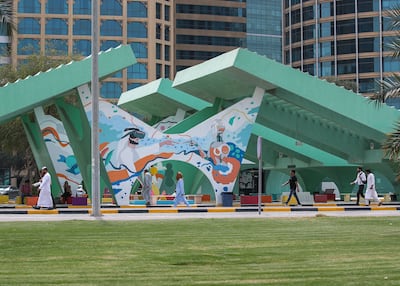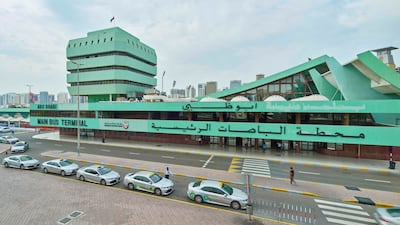The Abu Dhabi Main Bus Terminal is a landmark in form and function, and several works commissioned as part of the capital’s first public art biennial reflect the structure’s history and importance.
Designed by architect Georgi Kolarov and built in 1989, the terminal’s clean, modernist aesthetic stands out among the surrounding buildings in Al Wahdah.
The building remains as busy as the day it opened. Today, the terminal’s main halls are often bustling with commuters, as well as those shopping for groceries and eating at its cafes. Yet, there is one area in the terminal that is abandoned and dilapidated: the mezzanine level.
Its state of disrepair is particularly tragic considering its festive and bustling past. The mezzanine was used as a wedding hall in its heyday, an aspect of the terminal's history many may not be aware of.

Atelier Aziz Alqatami, an architecture studio in Kuwait, will be refurbishing the mezzanine level so that it can once again be a communal space. Though weddings may not be part of the programming, the restoration will transform the vast abandoned level into a public space, complete with a cafe, gallery and even a film screening area.
The project is dubbed Al Mahatta, or the station, and is scheduled to be completed by January. “When we were invited to participate, we were going through different parts of the city, and the bus terminal captivated us,” Alqatami, founder of the studio, says. “It has beautiful traffic, and there’s a lot of potential programmes to be developed there. We saw this abandoned mezzanine level, and we saw the potential.”
The original floor plan, structure and layout will be preserved. However, the space will be segmented across multiple designations. The main hall will become a reception area and cafe, whereas the kitchen will be transformed into workshops, a gallery and the film screening area.

“We're trying our best to be sensitive to the site because we understand that this is a renovation project, but at the same time we’re introducing a new programme,” Alqatami says. “The surgery that needs to be done needs to be very delicate. We want to utilise the wooden booths. We're keeping the maximum of the walls, and the tiles in the kitchen, which we’re trying not to touch, just clean.”
The design will also accentuate the horizontal nature of the space, while mindfully blending natural and artificial light. “One of the charms of the space is that it's a bit of a low ceiling space,” Khalid al Gharaballi, a partner at Atelier Aziz Alqatami, says. “We wanted to kind of underscore the horizontal feature, but also give the space its grandness.”
Alqatami adds: “Right now, there is a transition, different flooring in different parts, we’re thinking about unifying the floor, so you can see it as a unified space."
While the atelier is honouring the terminal's history and function, Emirati artist Zeinab Alhashemi is paying tribute to its design.
Even after decades of development in the area, the terminal remains distinct in its architecture. Its rigid geometry, with its slanted roofs and angular edges, is tastefully broken with unexpected curves. Due to its hard lines, the structure is often designated as Brutalist, referencing the aesthetic that came about in the West after the Second World War. Yet, there is an undeniable local twist to the terminal's architecture, namely with its arches and, of course, its vibrant teal colour.

Alhashemi has taken several design cues from the structure for her work at the biennial. Equilibrium comprises two identical sculptures presented just outside. Each sculpture is composed of a pair of concrete slabs that slant upward and are hoisted by a base with an arched design – a smaller facsimile of the form that looms behind it.
The terminal, Alhashemi says, has fascinated her since she was a child, seeing it “as a big green building". As she progressed in her career as an artist, she began wondering whether the structure was actually meant to be painted, or whether it was intended to remain bare, much like the brutalist architecture it was evidently inspired by.
“It is interesting because I think that maybe on this side of the world, we want to beautify things,” she says. “We want to give colour to things.” Nevertheless, Alhashemi says she wanted to pay tribute to the structure’s apparent Brutalist heritage. Her sculptures reflect the form of the terminal, but instead of being painted in a similar teal, Alhashemi left the concrete bare and covered its surface in grass.
Equilibrium neatly falls into Alhashemi’s body of work, which often contrasts industrial and natural elements. "I always try to dominate my materials over nature,” she says. “We can call it modernisation but I prefer to call it human interference. I think we always try to mimic nature, but in a way, we try to dominate nature.”
Alhashemi was adamant about using real grass as part of the work, saying astroturf would have defied the philosophy of the work, even if it would have been easier to maintain.
“The grass is still fresh and it will grow,” she says. “There were concerns about trimming the grass, but I said let it grow. There is no problem with trimming it once every other month. It doesn’t need to be trimmed perfectly.”
The grass, she says, is also meant to obscure the function of her sculptures. In fact, she is even wary of labelling the work as a sculpture, saying it may keep people from engaging with it, sitting down on its concrete ledge or lying on its grass. “I don't want to call it art," Alhashemi says. "I don't want to call it a bench. I don't want to call it a sculpture. It could be just camouflaging with the space. You could possibly notice it as art, and you might not think of it as art."


